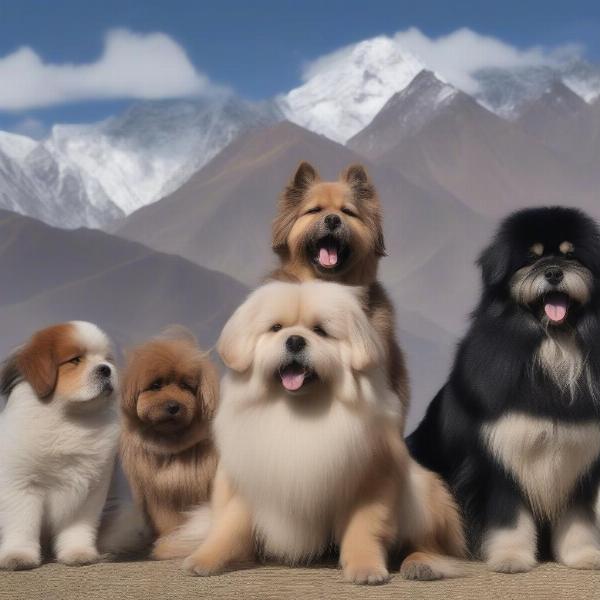Tibet, a land of towering mountains and ancient monasteries, is also the birthplace of several unique dog breeds. These remarkable dogs, adapted to the harsh Tibetan climate and often playing integral roles in Tibetan culture, are becoming increasingly popular worldwide. If you’re a crossword enthusiast and a dog lover, you’ve likely come across clues hinting at these Tibetan breeds. This article will delve into the fascinating world of dogs that originated in Tibet, providing valuable insights into their history, characteristics, and care.
 Tibetan Dog Breeds in Himalayan Landscape
Tibetan Dog Breeds in Himalayan Landscape
Unveiling the Tibetan Canine Heritage
Tibetan dogs are known for their resilience, intelligence, and distinctive appearances. Bred for centuries for specific purposes, from guarding livestock to companionship, these breeds possess unique traits that make them stand out. Their thick double coats protect them from the extreme cold of the Tibetan plateau, while their loyal and protective natures make them excellent family guardians. Let’s explore some of the most prominent Tibetan dog breeds you might encounter in a crossword puzzle.
What breeds instantly come to mind when thinking of Tibetan dogs? Likely, the majestic Tibetan Mastiff is the first. Known for its imposing size and impressive mane, this ancient breed was traditionally used to guard monasteries and homes. Other popular breeds include the Lhasa Apso, a small, long-haired dog originally bred as a palace sentinel, and the Tibetan Terrier, a playful and adaptable breed often referred to as the “Holy Dog of Tibet.”
Tibetan Dog Breeds: A Crossword Solver’s Guide
Here’s a closer look at the breeds commonly featured in crossword puzzles:
- Tibetan Mastiff: This giant breed is known for its imposing size and thick, luxurious coat. Its protective instincts and deep bark make it an excellent guard dog.
- Lhasa Apso: This small, long-haired breed originated as a companion dog in Tibetan monasteries. Its playful and affectionate personality makes it a popular family pet.
- Tibetan Spaniel: A small, alert dog with a distinctive, slightly domed head. They were often kept in monasteries, perched on high walls to act as watchdogs, alerting the Tibetan Mastiffs to any potential threats.
- Tibetan Terrier: Despite its name, the Tibetan Terrier is not a true terrier. This medium-sized breed is known for its long, flowing coat and playful, adaptable nature.
Caring for Your Tibetan Breed
Regardless of the specific breed, Tibetan dogs share some common care requirements. Their thick coats require regular grooming to prevent matting and tangling. They also benefit from regular exercise to maintain their physical and mental well-being. Understanding their unique needs, including their potential for altitude sickness if moved to lower elevations, is crucial for responsible ownership.
Dr. Anya Sharma, DVM, a specialist in Tibetan dog breeds, advises, “It’s important to remember that these breeds, while adaptable, still retain their inherent characteristics shaped by their Tibetan origins. Providing a stimulating environment that caters to their intelligence and protective instincts is key to a happy and well-adjusted dog.”
Conclusion
From the majestic Tibetan Mastiff to the playful Tibetan Terrier, dogs originating in Tibet offer a fascinating glimpse into the rich cultural heritage of the Himalayas. Whether you’re a crossword enthusiast, a prospective dog owner, or simply intrigued by these remarkable breeds, understanding their origins, characteristics, and care requirements is essential. By appreciating their unique history and needs, we can ensure these magnificent dogs continue to thrive for generations to come.
FAQ
- What is the largest Tibetan dog breed? The Tibetan Mastiff is the largest Tibetan dog breed.
- Are Tibetan dogs good family pets? While some breeds like the Lhasa Apso and Tibetan Terrier are generally good family pets, breeds like the Tibetan Mastiff require experienced owners due to their protective nature.
- Do Tibetan dogs need a lot of grooming? Yes, their thick double coats require regular brushing to prevent matting and tangles.
- What is the lifespan of a Tibetan dog? The lifespan varies depending on the breed, but generally ranges from 10-15 years.
- Are Tibetan dogs prone to any specific health issues? Some breeds are prone to hip dysplasia and eye problems.
About ILM Dog
ILM Dog (https://ilmdog.com) is your premier resource for expert advice on dog breeds, health, training, nutrition, grooming, and much more. We’re dedicated to providing dog owners worldwide with reliable, practical information to ensure the well-being of their canine companions. Whether you’re looking to choose the right breed or need advice on dog health and care, our team of experts is here to help. Contact us today at [email protected] or +44 20-3965-8624 for personalized advice and support.